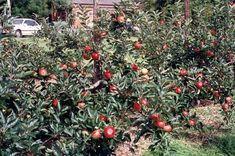
Based in Deil in the middle of the traditional Dutch growing region, Van Doorn markets Dutch-grown apples in the Netherlands, Germany, France, Scandinavia and Russia, with small amounts of Cox apples sent to the UK wholesale markets from time-to-time.
The apple sector is now getting additional attention from the company, says Edwin de Wit commercial manager: “We are expanding the apples business and looking for more customers and new growers. For the coming season, we have an additional 30-40 growers and we need to market them,” he says.
The new grower network enters year one of its relationship with Van Doorn with a good production period behind it. “Although the 2003 season was normal in terms of volume, there was some concern regarding quality because of the very hot growing conditions. Volumes will be higher this year though we are not yet sure by how much; picking will commence in October,” says de Wit. “Quality is looking good, as are sizes. Van Doorn has 100 growers this season, mainly growing the varieties Jonagold, Elstar, and some Booskop, with small production levels of other varieties such as Cox.”
The only gripe that growers have, says de Wit is price. “Last season’s apples have been demanding only 35-40 eurocents a kilo, which is not enough if you are selling apples that were picked last October, and you have cover the storage from May to July - these prices are not enough to compensate growers for producing good quality apples. This low price reflects the apple oversupply - there is so much on offer so prices are kept low.”
Under price-sensitive circumstances, using the highest percentage of the crop possible has always topped the list of grower requirements. Van Doorn looked east some time ago to achieve this objective. Larger sized apples are sent to Russia, says de Wit. He explains that when the Russian market was opened-up, larger sized and lesser quality apples were initially sent as Russian consumers were not used to either fresh fruit or good quality fruit, and in addition could not afford the best fruit on offer. “Larger sizes were the cheapest apples, so initially these were exported to Russia. In this way, the Russian market became accustomed to large apples and the preferences have not changed. What did change was the quality exported as the market began to appreciate and demand better quality. Now we send large-sized, Class I large fruit. For example, the best prices received are for 70-75mm or 75-80mm Jonagold and Elstar varieties in Europe, but when exporting to Russia, 85-90mm or 90-100mm are the popular sizes.”
Russian supplies are distributed using local traders, as no direct supply agreements exist with supermarkets. De Wit explains that for Germany, France and Scandinavia the company distributes to both wholesalers and directly to supermarkets, while in the local market, service providers negotiate with supermarket regarding apple programmes. “Germany is a big market for the Dutch produce industry and we are trying to establish a strong market position there but there is strong competition from countries such as Chile. Varieties like Jonagold have not increased in popularity over the past few years, unlike Braeburn and Gala which have become extremely popular apples, and this is what we are up against,” says de Wit.
New-found sources of competition of course are the new EU members, and de Wit says Poland will definitely be a threat at some stage, but it depends on “how much foreign companies will invest there, introduce new varieties and improve production techniques and packing facilities”.
He does not see too much interest from Dutch producers to invest in the Polish market. “Many companies have a large interest in the Dutch fresh produce industry already and by investing in the Polish apple sector would be increasing the competition with their own produce. Poland is the biggest apple producer in Europe but up until now, it has not been able to grow good-quality apples. Before joining the EU, a large amount of Polish apples were sent to Russia, but now that Poland is in the EU, local growers must also pay the same taxes as all EU members who export to Russia. This has made it more difficult.”
Van Doorn has instead invested in Belarus - four years ago - planting 400 hectares of apples, to be marketed in Russia. This strategy is different because we are competing directly with Polish production in Russia, rather than our own. We have planted 400ha of apples and next year we will have our first commercial volumes. The varieties grown are older types because the Russians are more interested in colour - they prefer red apples. Depending on how production and yields develop in the next two years, and if all goes well, we may look at expanding there.”